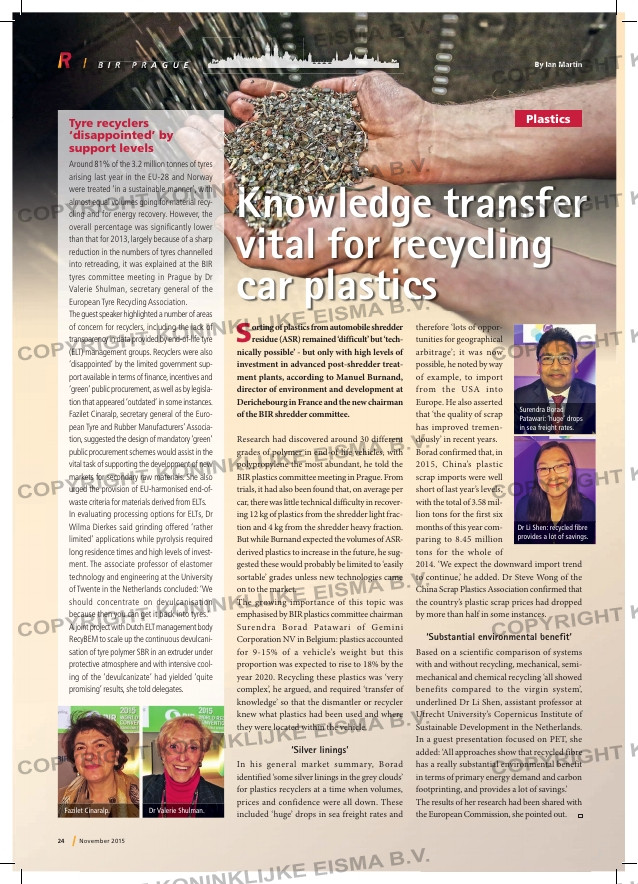Page 26 from: November 2015

24 November 2015
B I R P R A G U E
Sorting of plastics from automobile shredder residue (ASR) remained ‘difficult’ but ‘tech-
nically possible’ – but only with high levels of
investment in advanced post-shredder treat-
ment plants, according to Manuel Burnand,
director of environment and development at
Derichebourg in France and the new chairman
of the BIR shredder committee.
Research had discovered around 30 different
grades of polymer in end-of-life vehicles, with
polypropylene the most abundant, he told the
BIR plastics committee meeting in Prague. From
trials, it had also been found that, on average per
car, there was little technical difficulty in recover-
ing 12 kg of plastics from the shredder light frac-
tion and 4 kg from the shredder heavy fraction.
But while Burnand expected the volumes of ASR-
derived plastics to increase in the future, he sug-
gested these would probably be limited to ‘easily
sortable’ grades unless new technologies came
on to the market.
The growing importance of this topic was
emphasised by BIR plastics committee chairman
Surendra Borad Patawari of Gemini
Corporation NV in Belgium: plastics accounted
for 9-15% of a vehicle’s weight but this
proportion was expected to rise to 18% by the
year 2020. Recycling these plastics was ‘very
complex’, he argued, and required ‘transfer of
knowledge’ so that the dismantler or recycler
knew what plastics had been used and where
they were located within the vehicle.
‘Silver linings’
In his general market summary, Borad
identified ‘some silver linings in the grey clouds’
for plastics recyclers at a time when volumes,
prices and confidence were all down. These
included ‘huge’ drops in sea freight rates and
therefore ‘lots of oppor-
tunities for geographical
arbitrage’; it was now
possible, he noted by way
of example, to import
from the USA into
Europe. He also asserted
that ‘the quality of scrap
has improved tremen-
dously’ in recent years.
Borad confirmed that, in
2015, China’s plastic
scrap imports were well
short of last year’s levels,
with the total of 3.58 mil-
lion tons for the first six
months of this year com-
paring to 8.45 million
tons for the whole of
2014. ‘We expect the downward import trend
to continue,’ he added. Dr Steve Wong of the
China Scrap Plastics Association confirmed that
the country’s plastic scrap prices had dropped
by more than half in some instances.
‘Substantial environmental benefit’
Based on a scientific comparison of systems
with and without recycling, mechanical, semi-
mechanical and chemical recycling ‘all showed
benefits compared to the virgin system’,
underlined Dr Li Shen, assistant professor at
Utrecht University’s Copernicus Institute of
Sustainable Development in the Netherlands.
In a guest presentation focused on PET, she
added: ‘All approaches show that recycled fibre
has a really substantial environmental benefit
in terms of primary energy demand and carbon
footprinting, and provides a lot of savings.’
The results of her research had been shared with
the European Commission, she pointed out.
By Ian Martin
Plastics
Surendra Borad
Patawari: ‘huge’ drops
in sea freight rates.
Dr Li Shen: recycled fibre
provides a lot of savings.
Tyre recyclers
‘disappointed’ by
support levels
Around 81% of the 3.2 million tonnes of tyres
arising last year in the EU-28 and Norway
were treated ‘in a sustainable manner’, with
almost equal volumes going for material recy-
cling and for energy recovery. However, the
overall percentage was significantly lower
than that for 2013, largely because of a sharp
reduction in the numbers of tyres channelled
into retreading, it was explained at the BIR
tyres committee meeting in Prague by Dr
Valerie Shulman, secretary general of the
European Tyre Recycling Association.
The guest speaker highlighted a number of areas
of concern for recyclers, including the lack of
transparency in data provided by end-of-life tyre
(ELT) management groups. Recyclers were also
‘disappointed’ by the limited government sup-
port available in terms of finance, incentives and
‘green’ public procurement, as well as by legisla-
tion that appeared ‘outdated’ in some instances.
Fazilet Cinaralp, secretary general of the Euro-
pean Tyre and Rubber Manufacturers’ Associa-
tion, suggested the design of mandatory ‘green’
public procurement schemes would assist in the
vital task of supporting the development of new
markets for secondary raw materials. She also
urged the provision of EU-harmonised end-of-
waste criteria for materials derived from ELTs.
In evaluating processing options for ELTs, Dr
Wilma Dierkes said grinding offered ‘rather
limited’ applications while pyrolysis required
long residence times and high levels of invest-
ment. The associate professor of elastomer
technology and engineering at the University
of Twente in the Netherlands concluded: ‘We
should concentrate on devulcanisation
because then you can get it back into tyres.’
A joint project with Dutch ELT management body
RecyBEM to scale up the continuous devulcani-
sation of tyre polymer SBR in an extruder under
protective atmosphere and with intensive cool-
ing of the ‘devulcanizate’ had yielded ‘quite
promising’ results, she told delegates.
Knowledge transfer
vital for recycling
car plastics
Fazilet Cinaralp. Dr Valerie Shulman.



